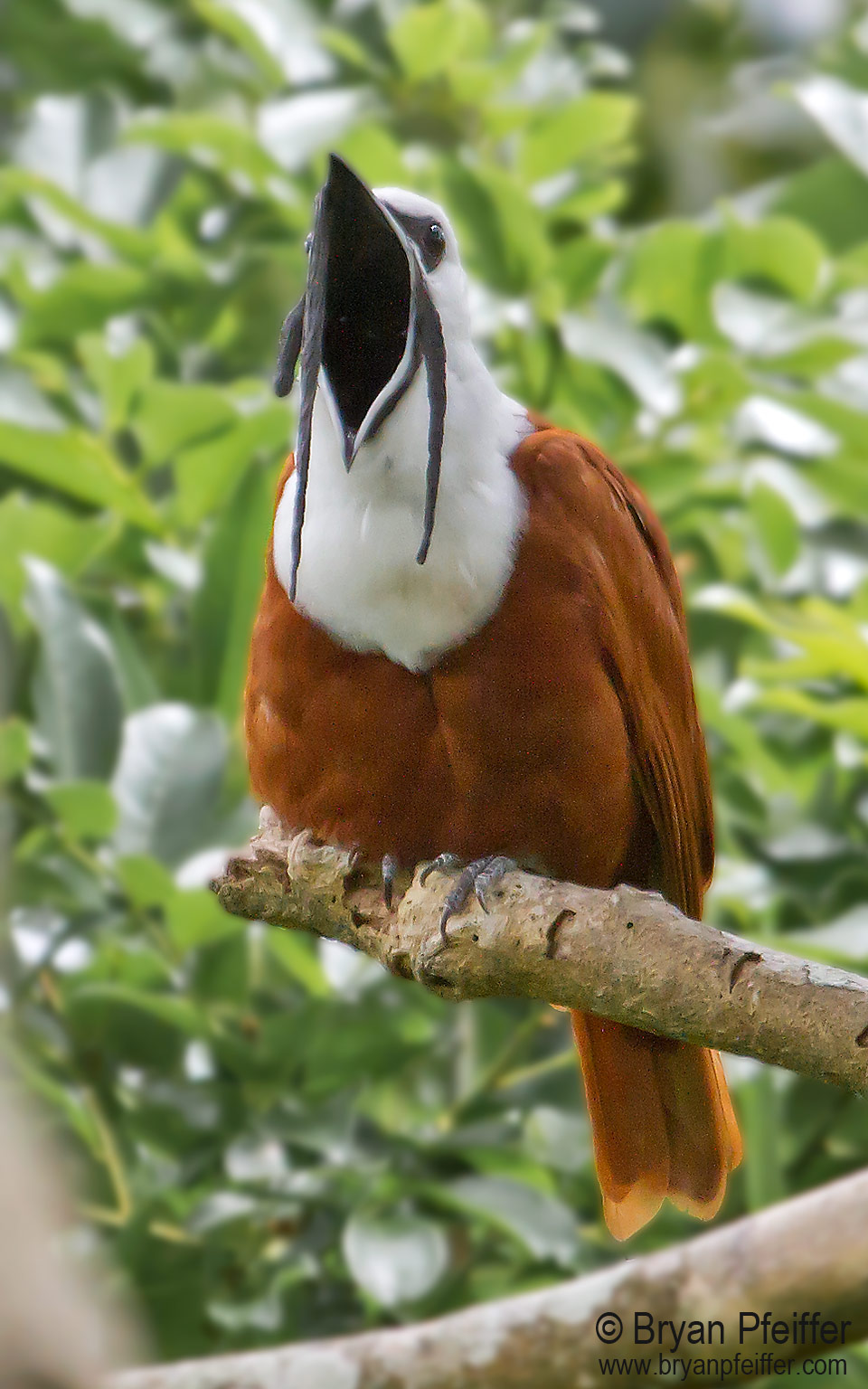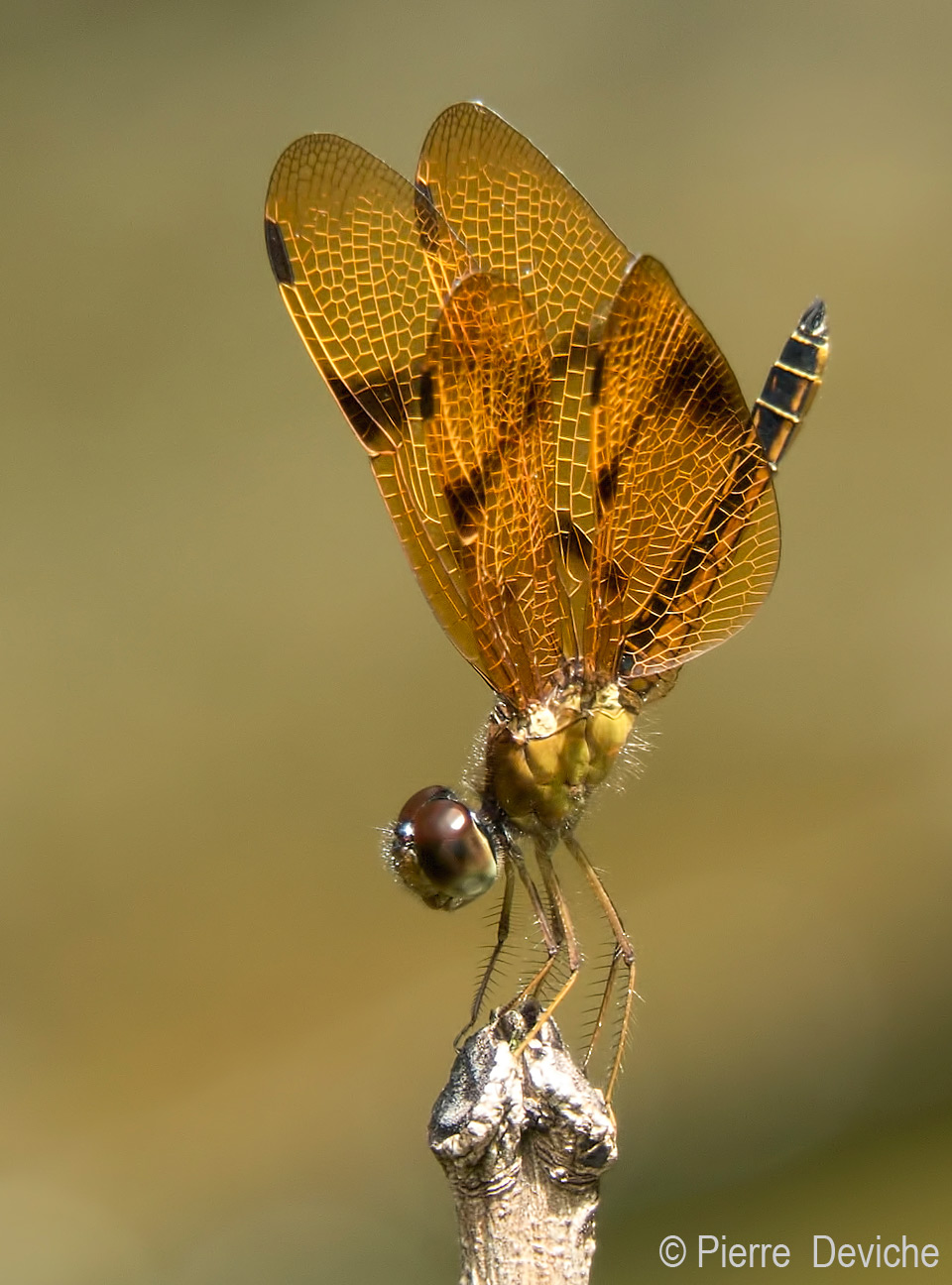In the Rainforest: Pleasure and Peril Among the Unknown
SPEND A LIFETIME IN THE RAINFOREST and you will learn but a fraction of its secrets. Here in Costa Rica, the drama of life on Earth plays out on a thousand stages big and small: in the green and the brown, in the mud and the river, in the forest and an orchid, in the rain and the heat.
A Three-wattled Bellbird yawns wide and shouts for a mate with an emphatic WONK! … a pause … and then a slow, sonorous … SCHWING! That fresh strawberry with the blue-candy limbs is a poison-dart frog that you dare not touch. Butterflies flash rainbows and audacity, and a few even broadcast a soft crack! as they snap gossamer wings. Here the largest damselflies in the world, as long as your hand, float and twinkle gold or azure in rare dappled light — then vanish into forest shadows. And a bullet ant, an inch long, can deliver a mile of suffering, a red-hot-electric-Dick-Cheney torture that will put you down for a day or more.
Among this grand diversity are standard inconveniences for human interlopers. June puts the rain in rainforest, redefines the notion of heat and humidity, and brings me to new frontiers of perspiration (rendering my rain parka basically worthless). In the humidity, my camera fails. At the famed Palo Verde wetland, the mosquitoes, in marauding clouds, are quiet, tenacious and quick to the attack. And in rustic cabins, which we share with scorpions, the first of which I had planned to move outside in an 8-ounce glass jar, I recall the scene from Jaws when the police chief, ladling chum at sea, gets his first look at the menacing shark. To my bunkmates I advise: “We’re gonna need a bigger jar.”
I mention the burdens of the tropics not to brag or to seem durable. (As it turns out, besides a thousand photos and infinite memories, I brought home an infection in my knee, which I am now killing with antibiotics.) I would bear far worse for this diversity. As it turns out, I did. In the forest I came to realize something more daunting than heat and mosquitoes and scorpions: ignorance.
I cannot know this place. Not as I know my wild home in Vermont, certainly, or other far-flung lands I frequent: the Grand Canyon, northern bogs, even the suburban hell of southeastern Michigan (where I have family). Oh, sure, in the rainforest I know a bellbird or a quetzal when I see one, some of the tropical butterflies, a few plants, and many of the dragonflies that zipped through my dreams last winter and stole away the cold. But I would need a library of field guides and immortality to know a fraction of what I saw in Costa Rica.
Field naturalists like to think we know our way around a forest — or at least can learn our way. Knowledge is comfort, after all. And we cannot love or fight to save that which we do not know — in plumage, pelage, behavior, habitat, abundance or any of the zillion ways we come to experience and enjoy nature, not the least of which is to put a name on things. Yeah, we like to name things. Well, most of us do. I recognize that some of you need no names to enjoy that red bird with black wings or that black-and-yellow butterfly that isn’t a Monarch. Not me. Along with the tangible pleasure of seeing and being with something in nature, naming is itself a tangible measure of satisfaction, the gratification of knowledge, which is the human nature of a naturalist. We name, therefore we are.
Yet among the unknown and untold diversity of Costa Rica, I could not name very much. But that was okay. In the tropics, where I’m as foreign as a polar bear, diversity is a providence to embrace rather than solve. Mystery is a welcome fate.
After all, if we’re not careful, knowledge can breed hubris. When we think we know our way around a forest, when we think we can name everything, our “certainty” can blind us to new discoveries. I’ve seen it in action — the comfort and confidence of the familiar. We must be wary of this and open to the unknown — and the potential for nature to surprise us. Fresh eyes make new discoveries — sometimes unwittingly — like those of a child.
So, humbled among the unnamed, I was content to lose myself in the company of orchids and bromeliads, frogs and glittering wings. I could leave much of the wisdom and identifications to companions — biologists like Bill Haber, who came to Costa Rica as a botanist nearly a half century ago but has now created nothing less than a masterpiece to help us identify dragonflies, and the intrepid Dennis Paulson, who has probably seen and humbly named more nature than anyone on the planet (and about whom you will read more later).
Yet even for Bill and Dennis, in no way over-confident and cocky, the rainforest still offers secrets. One of them is the audacious golden dragonfly pictured here, a Perithemis (Amberwing) species, which was flying at the famed Estación Biológica La Selva (La Selva Biological Station), where so many biologists before us have studied the forest and its fauna for decades and yet have not described this particular animal to science. Yep, a “new species” right under our noses and nets; we went to La Selva to learn more about it. On the way there, I asked Bill how I might distinguish this Perithemis from its congeners. “Oh, that easy,” he said “It’ll be the one you never see.” We got a few photos of rare males (thanks, Pierre!); females remain even more elusive in this often surveyed preserve. El misterio sigue.
So now that I’m home, I’ll soon send you a slide show of sloths and satyrs, of hummingbirds and hairstreaks, frogs and ferns. These images are, of course, but a fraction of what I encountered in Costa Rica. Many of these things I did indeed recognize and identify on my own, which I’ll admit made me happy. (Hey, I’m a boy naturalist, after all). Some I may have misidentified. But some of these still need names. Adelante!



As you know, in the tropics … it’s easy to have a wonderful time! 🙂
Wonderful photos! You must have had a wonderful time.
Hi Martha,
Wow, two Pfeiffers (no relation, except love if nature” in Guanecaste. Go figure. Hot hot hot and dry dry dry there. I guess they were in a drought. Bellbirds at Bajo del Tigre, below Monteverde. I hope to hear of your travels next winter!
Gotta get back there, Paul!
Nice to hear from you, Linda. Those flowerpiercers are quick, too. Hard to photograph.
Thanks, Barb. Yep, and not one threw poop at us!
Thanks! I hope to get back there to write again about the tropics.
Thanks, Charlie! I’m on my way to Maine!
Aw, shucks. Thanks, Terry. Great to hear from you. I hope you’re enjoying life “out there.”
As ever, excellent photography, Bryan. It adds so much to your naturalist writings!
Amazing photographs and beautifully done. Thanks for sharing, Bryan.
Wonderful! Really enjoyed this post, Bryan!
Hi Bryan, glad you are back from the wilds of southern travels. I enjoyed the slides and was especially happy to recognize many of the (by name) from my travels in Costa Rica and Peru. The capuchin monkeys are especially entertaining.
Cool! Looks amazing!
Thanks for this gift,Bryan. I love the beak on the slaty flower piercer!
Awesome bellbird photo Bryan! One of my favorite tropical birds. Can’t wait to hear the story behind that photo.
Bryan, I winter in Guanacaste,CR every year and certainly my experience is nothing like yours but at least I have witnessed some of what your photographs show. Beautiful slide show. Where did you encounter the Three Wattled Bellbird? The Fiery-throated Hummer photo is GEORGEOUS. Your time spent creating and posting the CR blog is very much appreciated. More, please! Now that I have taken your photography workshop can’t wait to return to CR in January
Excellent images, once again. Familiar with a few of the denizens from prior visits…. thanks for the reminder.
Thanks, Larry. I suspect you might have enjoyed one particular word (in caps) in there. 🙂
Thanks for the amazing photos Bryan. Hope you knee heals quickly.
Great writing and amazing photos. Thanks for sharing.